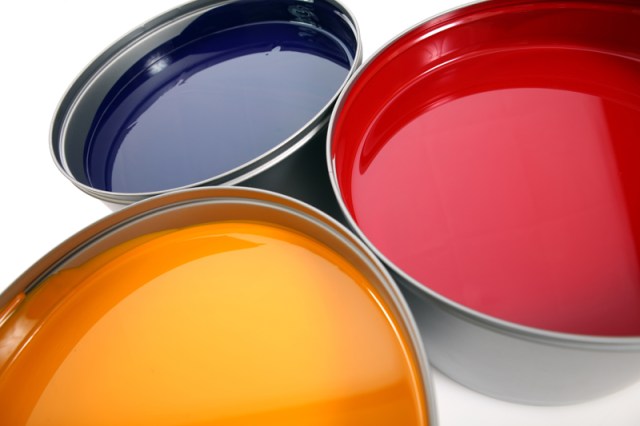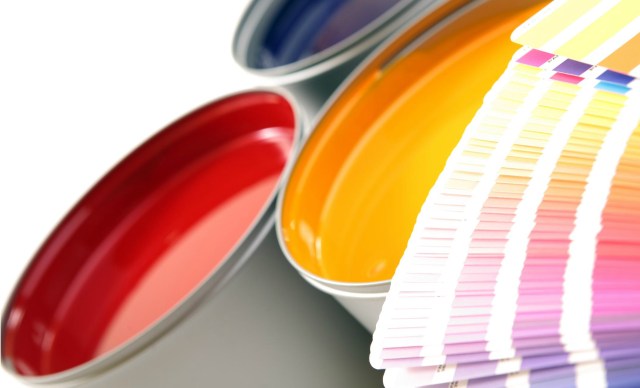
It only accounts for about 5% of a job’s cost and perhaps 5% of its environmental impact, but there’s nothing inconsequential about ink. It’s what makes print print. It’s the thin film that separates your next high-impact job from the stack of paper in the storeroom. With such an integral role in the printing process, it’s no wonder the environmental credentials of ink have been a focus for vendors and printers for some time.
Any chemicals are an obvious target when talking about sustainability. Ink manufacturers have been diligent in addressing environmental concerns and have significantly altered their product chemistries. Printers responded by readily accepting new ink technology. Vendors and printers alike agree this wasn’t due to bleeding-heart green ideals but thanks to valid business cases.
Mineral oil-based inks were the mainstay of offset printers from the 1960s, and provided very high print quality – the kind of quality we all now take for granted. The problem is they’re made from mineral oils, which are not renewable, produce volatile organic compounds (VOCs), which are very toxic and evaporate into the air, and they need to be cleaned up with toxic solvent-based solutions.
The main competitors are vegetable-based inks. These relative newcomers, are rapidly taking market share. They take longer to dry than petroleum-based inks, but release significantly fewer VOCs into the atmosphere in the process. As a bonus, water-based cleaners rather than solvents can be used to clean the press, further reducing the use of VOCs. When paper products are recycled, vegetable-based inks are much easier to remove from the paper, and produce less hazardous waste.
In terms of quality and productivity, mineral oil inks can generally provide a higher gloss and dry faster than vegetable-based inks. The most common vegetable-based inks are made from soya beans, often supplied from the US, South America and Asia. Other crops used for vegetable-based inks include linseed, corn, canola, coconuts, and even walnuts.
Flexo and gravure inks are usually not formulated with oil bases, and most ink manufacturers have turned to water-based formulations for better environmental outcomes in these processes.
According to Brett Wark of GBC Australia, which supplies the Van Son range of inks, the vast majority of offset inks now are “hybrid” inks, a blend of mineral- and vegetable-based oils. He says there are few mineral oil-based inks still being used in Australia, mostly by “small printers who still use old presses and haven’t made the adjustments in their processes to fit environmental concerns”.
Consumable confusion
Jason Kent of DIC Australia agrees that ink demands have changed, but there is some confusion about exactly what “eco inks” really are. “When people talk about ‘green’ inks, it can often mean different things to different people,” he says.
“From an ink manufacturer’s perspective, a ‘green’ ink is one that contains a higher level on vegetable oils and a low VOC content. It’s important to realise, however, that different inks contain different levels of vegetable oil. A good question to ask your supplier is: ‘Is this ink mineral oil free?’
“The National Association of Printing Ink Manufacturers has data on the BRC Index of inks from all major ink manufacturers. The BRC Index is a measurement of the Bio Derived Renewable Resource Content.”
Kevin Birch, consumables product manager at Heidelberg Australia New Zealand, agrees that printers have changed their ink habits. “Most of our customers want a soy-based ink, especially in the past five or six years. But they’re still driven by price. Our 100% VOC-free ink is available, but due to sale volumes not being there yet the price is a little higher, and that deters people [from buying them].”
Heidelberg’s consumables sales manager, Bill Wall, adds: “We’ve dropped all our mineral-based inks, and that was basically decided by the market. They weren’t really wanted anymore. People are interested in vegetable oil-based inks, but only at a price.”
As far as press performance is concerned, inks that are based partly or wholly on vegetable oils will generally perform similarly to mineral inks. However, vegetable-based inks tend to exhibit higher levels of “ink fly” and misting compared with mineral oil-based inks of similar rheologies (‘rheology’ is the science dealing with the deformation and flow of matter). Vegetable inks also tend to tolerate too much dampening, which can result in issues with ink sling, set-off and marking.
DIC graphics business manager Jason Kent sees distinct advantages in using vegetable-based inks. “Other than the fact that the inks are manufactured from a renewable resource, the main on-press advantage is that higher levels of vegetable oil tend to cause less blanket piling.
“One of the factors that is often overlooked is the types of chemicals used to clean the ink from blankets and rollers. You can be using the lowest VOC ink available on the market but if you wash it up with highly flammable, aromatic solvents like Xylene, then it’s all in vain really,” adds Kent.
“I believe printers are being driven by their customers,” says Wark. “Customers have become more environmentally conscious. There has been a commitment to go to a higher base of vegetable- or soy-based inks, but not a 100% commitment.
“The inks on the market are generally ‘hybrids’. They still have a certain percentage of VOCs in them, or mineral oils and their derivatives. In my experience, the vegetable-based inks are not as forgiving as mineral oil inks. The ink/water balance comes into play earlier – you tend to get emulsification quite early because the vegetable based inks have a quicker uptake of water and are more subject to emulsification,” adds Wark.
Why go waterless?
Waterless printing provides another alternative for printers who wish to take a more environmentally friendly route.
According to the International Waterless Printing Association, the main difference between waterless and conventional inks is in the resins, or “vehicles”, used. Vehicles for waterless inks are selected for their rheological properties and tend to have higher viscosities than resins used in conventional ink systems. But temperature affects viscosity, and removal of water from the offset process removes its cooling effect on the plate surface. This tends to cause a temperature increase at the plate cylinder due to friction. Because of the higher initial viscosities of waterless inks, there is also heat generation in the roller train caused by the friction of milling the ink through the rollers. This heat is why press temperature control systems are required in the printing unit. By maintaining a constant temperature, the ink’s viscosity can be maintained at its optimum level.
So in offset printing, vegetable-based inks offer numerous environmental advantages compared with mineral-based inks. But it is not all sweetness and light. Many of the crops from which the soya beans and other raw materials come are genetically modified (although modified genes are not actually present in the inks themselves due to a high-temperature process that destroys any proteins).
The vegetable products often come from regions where genetically modified crops dominate as monocultures, which can lead to severe hardship for local farmers if crops fail, and also impact on local biodiversity. This has been the case in Argentina, Brazil, Chile and Paraguay, among others, according to The Soil Association, a leading UK based organic organisation of scientists and farmers.
Sydney-based Focus Press is one local company that has switched to hybrid vegetable inks, and enjoyed several other benefits along the way.
Factory manager Chris Kellis says: “We changed inks about four years ago. At the same time, we dropped our alcohol to zero so it was quite a challenge, but we were soon printing nice and bright, very sharp, and consistently. We didn’t really experience any major problems at all when we changed across. It was a confidence booster for the printers. Taking out the alcohol was a bigger environmental shift than changing inks, but it all makes a difference.
“We use Toyo Hy-Unity soy-based hybrid ink. It has a big window for water and it’s quite quick-setting. It has good dot gain and the colour consistency is fantastic. It’s also ISO-certified, which is very important for us. I’m almost certain that we’ve cut the amount of ink we’re using. It’s a brighter ink so you don’t have to run it as high, which also cuts drying time, especially for backing up.”
Kellis says Focus Press will change its inks again when he feels the time is right to move to fully vegetable-based inks.
“We will go to full vegetable-based inks but I don’t think they’ve got them quite right yet,” he says. “I’m waiting to see when they are as good as the hybrid ink we’re using, and we’ll change over as soon as that’s happening.”
Digital decisions
Digital print has undergone a similar metamorphosis in its processes. For the production of signs, banners, retail displays and other products that demand a reasonably long life, especially for outdoor use, solvent-based inks were the de facto standard. That has changed significantly in the last few years though, as manufacturers found other possibilities.
Most traditional solvent-based inks have 60-70% solvents, which contain VOC toxins that have to evaporate. In other words, 60-70% of the ink is “wasted” in the printing process. Solvents evaporating into the air aren’t good for employees or the environment.
UV inks can be considered more environmentally friendly because, unlike their solvent-based counterparts, 100% of the ink is used. UV ink undergoes an instant cure process, meaning almost no drying time, and hence no wasted time.
More recently, latex inks have entered the market, offering a water-based solution. They have some restrictions on the kind of substrates that can be used, and they are presently more expensive than other ink types, but that will likely change as they gain more market share, which tends to drive prices down.
Look Print, based in Sydney’s inner west, is an innovative digital print company that produces a wide variety of signage, promotional graphics, display, banners and other products. Director David Leach says that the company underwent process changes recently, for both environmental and business reasons.
“We were originally almost entirely solvent-based,” he says. “They did produce a good product but gave us problems disposing of the inks, fumes in the place, health and safety issues. We had to have huge ventilation fans on all the time. We still have large fans on all the time but we do that to keep the air fresher rather than keeping it safe.
“We have changed to water-based inks, like latex inks, and we’ve also changed to UV inks. UV inks have a lot more solids in them so you end up with far less environmental impact using UV inks
than solvent inks.
“Latex inks are the new inks on the block. They’re water-based and are much more environmentally friendly. HP has latex inks but there are two or three other brands that are claiming substantial differentiation with the HP brand inks, which will be coming on the market very shortly,” says Leach.
“Latex inks give us very good performance, although they are restricted on the number of materials they can print onto. In some cases, you can print onto particular media but you’ll be printing at a much slower speed.
“They have such a high water content that the biggest challenge is to make sure that the prints dry properly, especially if you’re printing roll-to-roll. Roll-to-sheet is not much of a problem, but for roll-to-roll you might find that you need to print slower or put in additional drying facilities, which of course adds to the environmental impact.
“They are also substantially more expensive than UV inks. As volumes increase and competition increases, I think we’ll find that prices will come down though,” adds Leach.
While inks may make a minor contribution to the broader environmental picture in print production, it’s an area where, almost universally in Australia, printers have quickly taken the initiative. It’s also an area where new ideas in environmental performance are still being developed, so this story does not yet have an end. That’s good news for both printers and their customers.
Case study: Signarama Mona Vale
Signarama Mona Vale, on Sydney’s northern beaches, supplies a broad selection of banners, signs, display graphics and cut lettering for both indoor and outdoor use. The company has always had a clear environmental focus, says director Margie Layman.
“We use two different inks in our business. We have Roland’s EcoSol Max inks in our Roland DG printer, which have no VOCs. We changed to those inks as part of Roland’s environmental initiative, for cutting down on the amount of solvent in the inks, about six years ago. The other ink we use, for our Teckstorm flatbed printer, is a UV ink.”
Those decisions were simple enough, she says, because health and safety were always top of mind. “Those inks are for environmental and health reasons. We had a staff member who had worked in a full solvent workplace, and the hacking cough he had every day was awful, and he was so young. The environment is one thing, but the health and wellbeing of your staff is another thing altogether.”
Layman has no doubts about final product quality. Even outdoor prints using UV inks make the grade.
“We’ve been in this business for six years now and we have prints out there, done with the original, first-release EcoSol inks (which weren’t as good as the present ones), and those prints still look as good as the day they were put up. I’ve heard about solvent inks being the only ones for outdoor use, but I’m not convinced. I think if you do it properly – if you use the right inks on the right media, and you print in the right conditions – you’re going to get as much life as you would from solvent inks.”
The directors have researched new latex inks, but are yet to be convinced to take them on just yet, although it’s certainly a possibility in the future.
“We’ve just looked at some of the new latex inks at the recent Signarama expo, and we’re thinking, ‘Interesting, but we need to see more’,” she says.
“They say you use less ink, which is a positive, but I don’t think the evidence is there just yet for us to get involved, but we probably will eventually. We’re always looking at ways to move forward, and I
think our industry needs to do that.”
Comment below to have your say on this story.
If you have a news story or tip-off, get in touch at editorial@sprinter.com.au.
Sign up to the Sprinter newsletter



